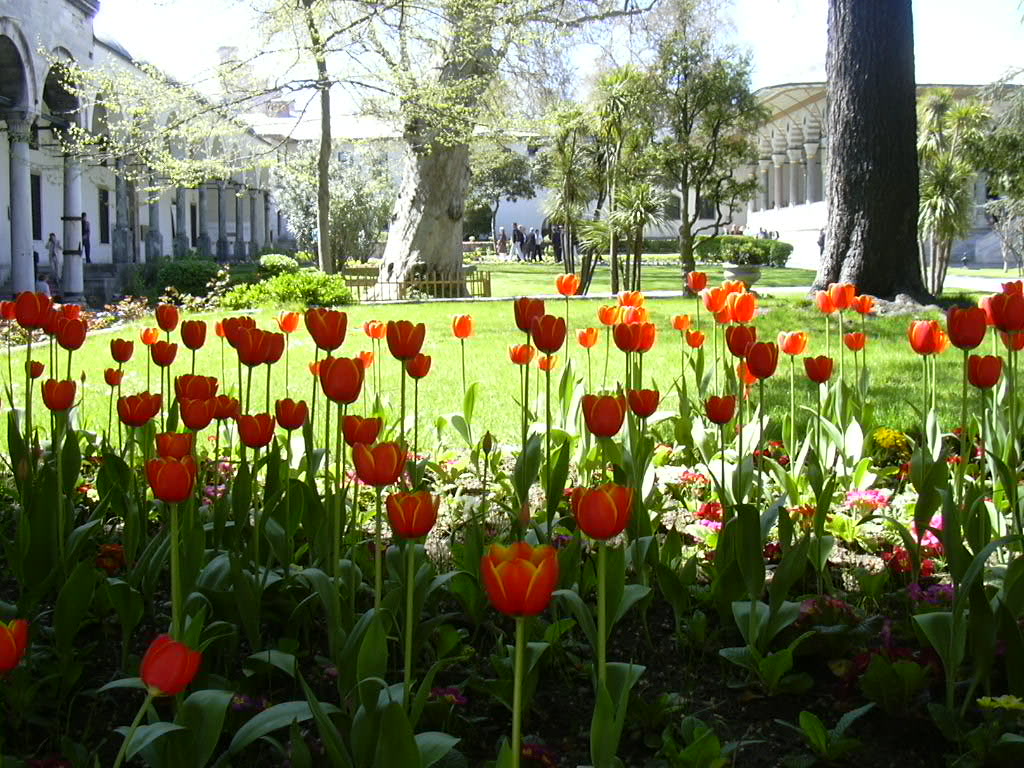
Tulips in TopKapi Palace Garden
The reign of Sultan Ahmet III [1703-1730] was a peaceful period, and the Sultan and his Grand Vizir sent ambassadors to many European countries, with orders to take note of any useful inventions, fortresses, factories and works of civilisation that could be adapted for use in Turkey. One result of this was to introduce baroque architecture to Istanbul.
Baroque Fountain of Ahmet III at entrance to Top Kapi Palace, Istanbul [built 1728]
The Ambassador to France sent back sketches of the Chateau de Fontainebleau. Based on these plans, the Sultan had a new summer palace built at Kagithane on the Golden Horn. All along the Bosphorus, nobles set about building grandiose residences surrounded by gardens, where the dominant flower was the tulip. For more on the Turkish passion for tulips see here: tulips
The reign of Ahmet III is known as the Tulip Period. Ahmet set up an annual tulip festival, which was held around the first full moon in April.
The famous traveller, Evliya Çelebi, who visited the tulip gardens at Kagithane says:
The reign of Ahmet III is known as the Tulip Period. Ahmet set up an annual tulip festival, which was held around the first full moon in April.
The famous traveller, Evliya Çelebi, who visited the tulip gardens at Kagithane says:
Those who come here at tulip time go into ecstasies.
Aynalikavak Kasri
This little kasir, or pavilion, is all that remains of a once enormous royal palace set in a vast park. The grounds were used to cultivate many varieties of trees and flowers. There are tulips there in season even now.
All the huge wooden palaces have disappeared, through age, decay, and especially fire. Some have been replaced by stone buildings. The Ciragan palace was rebuilt several times and is currently a luxury hotel. The version in this picture is from about 1840.
All the huge wooden palaces have disappeared, through age, decay, and especially fire. Some have been replaced by stone buildings. The Ciragan palace was rebuilt several times and is currently a luxury hotel. The version in this picture is from about 1840.
The old Ciragan palace,
In the early 19th century, this enormous palace is where the Sultan took his court for the summer. If it was necessary to travel into the main city, caiques were the favoured means of transport. The number of rowers depended on rank and wealth. The Sultan could have 20 pairs of rowers, making his boat super fast. And he had a silk covered kiosk to travel in.
When the court went on a visit from one palace to another, the spectacle of a flotilla of these boats gliding along in procession was breath-taking, according to the French Ambassador.
Pictures of some of these lost palaces can be seen in the paintings of the 18th century artist Antoine-Ignace Melling and in the sketches of Julia Pardoe's 'The Beauties of the Bosphorus', 1840.





No comments:
Post a Comment